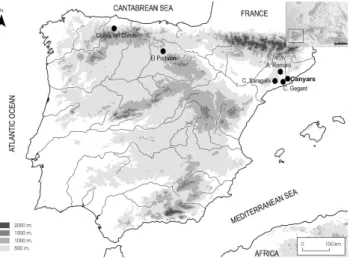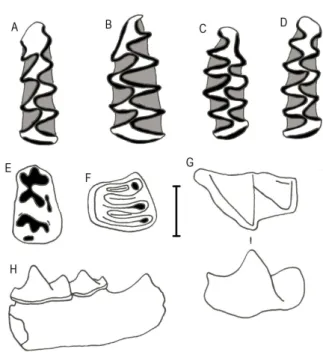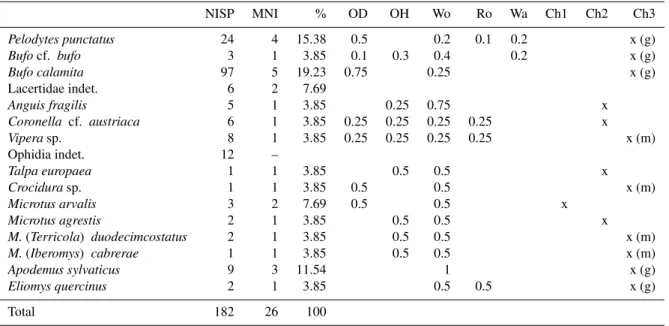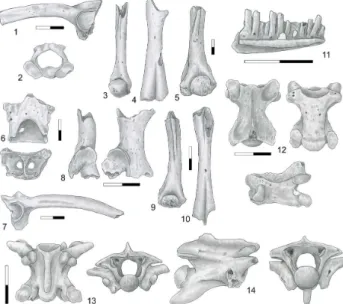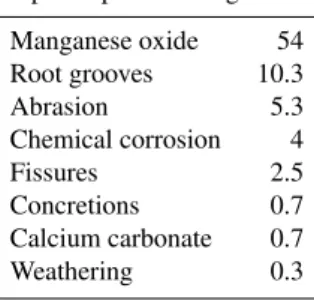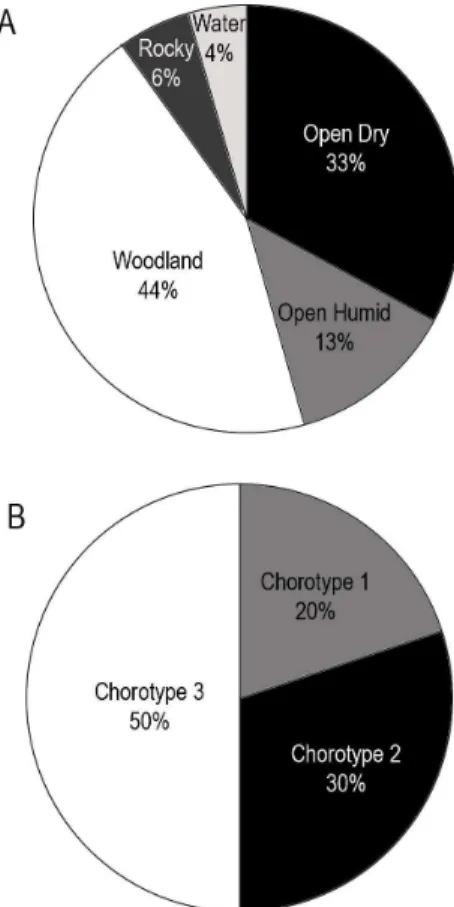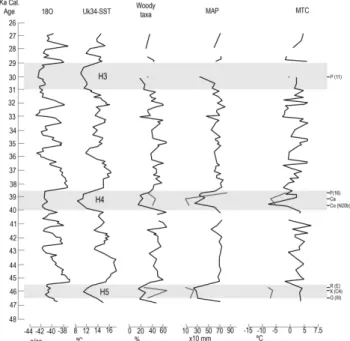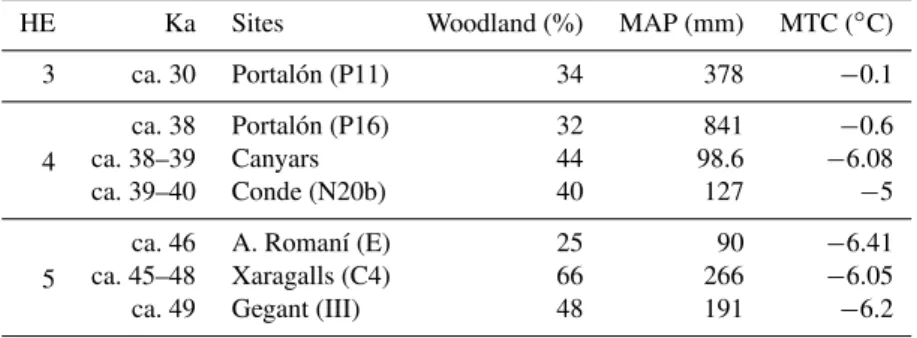www.clim-past.net/9/1053/2013/ doi:10.5194/cp-9-1053-2013
© Author(s) 2013. CC Attribution 3.0 License.
Climate
of the Past
Geoscientiic
Geoscientiic
Geoscientiic
Geoscientiic
Heinrich event 4 characterized by terrestrial proxies in
southwestern Europe
J. M. L´opez-Garc´ıa1, H.-A. Blain2,3, M. Benn`asar2,3, M. Sanz4, and J. Daura4
1Gruppo di Ricerca di Paleobiologia e Preistoria. Dipartamento di Studi Umanistici,
Universit`a degli Studi di Ferrara. C.so Ercole 1 d’Este 32, 44121 Ferrara, Italy
2IPHES, Institut Catal`a de Paleoecologia Humana i Evoluci´o Social, C/Escorxador s/n, 43003 Tarragona, Spain 3Area de Prehist`oria, Universitat Rovira i Virgili (URV), Avinguda de Catalunya 35, 43002 Tarragona, Spain`
4Grup de Recerca del Quaternari, SERP, Dept. Prehist`oria, H. Antiga i Arqueologia, Universitat de Barcelona, C/Montalegre,
6, 08001 Barcelona, Spain
Correspondence to:J. M. L´opez-Garc´ıa (lpzjmn@unife.it)
Received: 13 December 2012 – Published in Clim. Past Discuss.: 4 February 2013 Revised: 15 April 2013 – Accepted: 15 April 2013 – Published: 7 May 2013
Abstract.Heinrich event 4 (H4) is well documented in the North Atlantic Ocean as a cooling event that occurred be-tween 39 and 40 Ka. Deep-sea cores around the Iberian Peninsula coastline have been analysed to characterize the H4 event, but there are no data on the terrestrial response to this event. Here we present for the first time an analy-sis of terrestrial proxies for characterizing the H4 event, us-ing the small-vertebrate assemblage (comprisus-ing small mam-mals, squamates and amphibians) from Terrassa Riera dels Canyars, an archaeo-palaeontological deposit located on the seaboard of the northeastern Iberian Peninsula. This assem-blage shows that the H4 event is characterized in northeastern Iberia by harsher and drier terrestrial conditions than today. Our results were compared with other proxies such as pollen, charcoal, phytolith, avifauna and large-mammal data avail-able for this site, as well as with the general H4 event fluc-tuations and with other sites where H4 and the previous and subsequent Heinrich events (H5 and H3) have been detected in the Mediterranean and Atlantic regions of the Iberian Peninsula. We conclude that the terrestrial proxies follow the same patterns as the climatic and environmental conditions detected by the deep-sea cores at the Iberian margins.
1 Introduction
The Heinrich events have been generally defined, accord-ing to Cayre et al. (1999), by a decrease inδ18O, peaks in
Fig. 1.Location of the sites mentioned in text in the Iberian Penin-sula, including Canyars (Terrasses de la Riera dels Canyars).
terrestrial response to the H4 event in the Iberian Peninsula (S´anchez-Go˜ni et al., 2002; Sepulchre et al., 2007; Naughton et al., 2009; Fletcher and Sanchez-Go˜ni, 2008; Fletcher et al., 2010; Bout-Roumazille et al., 2007; Combourieu Nebout et al., 2002, among many others). Here we present for the first time a characterization of the environment and climate of the H4 event based on the small-vertebrate assemblage of the Terrasses de la Riera dels Canyars (henceforth, Can-yars). Our results are compared with the pollen, charcoal, phytolith, avifauna and large-mammal data obtained for this site (Daura et al., 2013), as well as with the general H4 event fluctuations to see whether the phases detected by Naughton et al. (2009) can be observed for the Canyars data. They are also compared with data from other sites where H4 and the previous and subsequent Heinrich events (H5 and H3) have been detected in the Mediterranean and Atlantic regions of the Iberian Peninsula, to observe whether or not the terres-trial proxies follow the same patterns as the climatic and en-vironmental conditions detected by the deep-sea cores at the Iberian margins.
2 Site description and chronology
Canyars is a fluvial deposit located in the town of Gav`a, some 20 km to the west of Barcelona, in Vall de la Sentiu, one of the creeks originating at the foot of the Garraf Massif that flows into the beaches of the Mediterranean seaboard. The site was discovered in 2005 (Daura and Sanz, 2009; Daura et al., 2013) by an amateur archaeologist (C. Valls) and com-pletely excavated by the Grup de Recerca del Quaternari from June to November 2007.
Nowadays, Canyars is located in an abandoned gravel-pit that remained active until the 1960s. Pleistocene fossils from the same area were already known. The first discovery from Vall de la Sentiu was an Upper Pleistocene
palaeonto-Fig. 2.Plot of the Canyars14C dates, calibrated with the Intcal09 curve (Reimer et al., 2009) and compared with the North Green-land Ice Core Project (NGRIP)δ18O ice-core record of Svensson et al. (2006) and Andersen et al. (2005), showing GI interestadials and Heinrich Event 4 according to Svensson et al. (2008) (prepared using OxCal vs. 4.1.7; Bronk Ramsey, 2009).
logical collection from an emplacement that is not known precisely (Villalta, 1953); another corresponds to an iso-lated proboscidean remains (cf.Mammuthus) from a differ-ent gravel-pit 700 m from Canyars (Daura and Sanz, 2009). Other palaeontological remains from adjacent valleys have been recovered in the course of archaeological survey exca-vations; Riera de Sant Llorenc¸ has provided large-mammal remains, mainlyMammuthus, CoelodontaandEquus(Daura et al., 2013).
Canyars is located at the confluence of two creeks, Ri-era dels Canyars and RiRi-era de Can Llong. The former is the main stream, and its distal part probably consisted of a floodplain crossed by channels, nowadays modified by farm-ing activity (Daura et al., 2013). A total of 9 lithological units have been described, consisting of a poorly sorted and coarse-grained complex of gradational and incised fluvial de-posits. Palaeontological remains come from the only archae-ological unit (MLU, Middle Lutitic Unit), consisting of mud-supported gravel filling a well-defined palaeochannel (LDU, Lower Detritical Unit).
Several charcoal samples were collected for radiocar-bon dating, with a14C dating result of∼34.6 14C (∼39.6 cal.) Ka (overall mean age estimate from four radiocarbon datings by Daura et al., 2013) (Table 1; Fig. 2).
3 Material and methods
3.1 Small-vertebrate sorting and palaeontological study
Table 1.Radiocarbon dates from Canyars. Ages (BP, before present) are calibrated with the OxCal 4.1.7 software (Bronk Ramsey, 1995) using the IntCal09 curve (Reimer et al., 2009).
Site Inventory Material Lab# Pre-treatment δ13C AgeBP calBP(2 ) TC07-I-L24-MCV Charcoal Beta273965 ABA −23.5 ‰ 33 800±350 37 405–39 720
(Pinus sylvestristype)
TC07-I-L25-MCV Charcoal OxA-23643 ABA −23.0 ‰ 34 540±330 38 756–40 516 (Pinus sylvestristype) OxA-2416-44 ABOx-SC −22.89 ‰ 34 980±350 39 048–41 004 TC07-I-L25-MCV Charcoal OxA-23644 ABA −23.35 ‰ 34 810±360 38 904–40 849 (Pinus sylvestristype) OxA-24057 ABOx-SC −22.77 ‰ 34 900±340 38 993–40 916
mesh screens during fieldwork, and ∼500 kg of the sam-ple was water-sieved (1.5–0.5 mm) in the La Guixera labora-tory (Castelldefels, Barcelona). The fossils were processed, sorted and classified at the Institut de Paleoecologia Humana y Evoluci´o Social of the University Rovira i Virgili (Tarrag-ona, Spain). The assemblage includes a total of 362 frag-ments, 182 of which were identified to genus or species level and correspond to a minimum number of 26 small verte-brates, representing at least 15 taxa (Table 2; Figs. 3, 4). The fragments were identified following the general criteria given by Furi´o (2007) for insectivores, Van der Meulen (1973) and Cuenca-Besc´os et al. (2010) for rodents, and Bailon (1999), Sanchiz et al. (2002), Blain (2005, 2009) and Szynd-lar (1984) for the herpetofauna. The specific attribution of this material rests principally on the best diagnostic elements: humerus, ilium, scapula and sacrum for anurans; jaws and vertebrae for lizards, vertebrae for snakes; mandible, max-illa and isolated teeth for shrews; isolated teeth and humerus for Talpidae; first lower molars for Arvicolinae; and isolated teeth forApodemus sylvaticusandEliomys quercinus. More-over, the fossils were grouped using the minimum-number-of-individuals (MNI) method, by means of which we deter-mined the sample (i.e. from each level) by counting the best diagnostic elements, taking into account, whenever possible, laterality and (for amphibians) sex.
3.2 Palaeoenvironmental reconstruction
In order to reconstruct the palaeoenvironment at Canyars, we use the method of habitat weightings (see Evans et al., 1981; Andrews, 2006), distributing each small-vertebrate taxon in the habitat(s) where it can be found at present in the Iberian Peninsula. Habitats are divided into five types (in accor-dance with Cuenca-Besc´os et al., 2005, 2009; Blain et al., 2008; Rodriguez et al., 2011; L´opez-Garc´ıa et al., 2010a, 2011a). These types are detailed as follows (Table 2): open dry: meadows under seasonal climate change; open hu-mid: evergreen meadows with dense pastures and suitable topsoil; woodland: mature forest including woodland mar-gins and forest patches, with moderate ground cover; wa-ter: areas along streams, lakes and ponds; rocky: areas with a suitable rocky or stony substratum. The “Ch1&Ch2”
Fig. 3.Some small mammals from Canyars. A: first left lower mo-lar (m1) Microtus (Terricola) duodecimcostatus (occlusal view); B: m1 leftMicrotus (Iberomys) cabrerae(occlusal view); C: m1 rightMicrotus agrestis(occlusal view); D: m1 rightMicrotus ar-valis(occlusal view); E: m1 rightApodemus sylvaticus (occlusal view); F: m1 rightEliomys quercinus(occlusal view); G: third left lower molar (m3)Talpa europaea(occlusal and labial views); H: left mandible (m2-m3)Crocidurasp. Scale 1 mm.
Table 2.Representation of the number of identified specimens (NISP), the minimum number of individuals (MNI) and the percentage of the MNI (%) for the small vertebrates from Canyars, and the small-vertebrate distribution by habitat and by chorotype. OD, open dry; OH, open humid; Wo, woodland/woodland-edge; Ro, rocky; Wa, water; Ch1, chorotype 1; Ch2, chorotype 2; Ch3, chorotype 3; (g), generalist; (m), Mediterranean requirements; indet., indeterminate. x represents the relationship between chorotypes and taxa.
NISP MNI % OD OH Wo Ro Wa Ch1 Ch2 Ch3
Pelodytes punctatus 24 4 15.38 0.5 0.2 0.1 0.2 x (g)
Bufocf. bufo 3 1 3.85 0.1 0.3 0.4 0.2 x (g)
Bufo calamita 97 5 19.23 0.75 0.25 x (g)
Lacertidae indet. 6 2 7.69
Anguis fragilis 5 1 3.85 0.25 0.75 x
Coronella cf. austriaca 6 1 3.85 0.25 0.25 0.25 0.25 x
Viperasp. 8 1 3.85 0.25 0.25 0.25 0.25 x (m)
Ophidia indet. 12 –
Talpa europaea 1 1 3.85 0.5 0.5 x
Crocidurasp. 1 1 3.85 0.5 0.5 x (m)
Microtus arvalis 3 2 7.69 0.5 0.5 x
Microtus agrestis 2 1 3.85 0.5 0.5 x
M.(Terricola) duodecimcostatus 2 1 3.85 0.5 0.5 x (m)
M.(Iberomys) cabrerae 1 1 3.85 0.5 0.5 x (m)
Apodemus sylvaticus 9 3 11.54 1 x (g)
Eliomys quercinus 2 1 3.85 0.5 0.5 x (g)
Total 182 26 100
3: includes non-strictly Mediterranean species and strictly Mediterranean species, with a broad distribution in Catalonia and without very strict requirements.
3.3 Palaeoclimatic reconstruction
Climatically, the Iberian Peninsula may be considered a minicontinent due to its large latitudinal range (between the parallels of 36◦ and 44◦N), its geographical position be-tween Atlantic (temperate–cold) and African–Mediterranean (temperate–warm or subtropical) influences, and its complex orography. The Iberian Peninsula is one of the most moun-tainous areas in Europe, and these mountains play a major role in the characterization of its climatic diversity. Climatic conditions may change abruptly over a few hundred kilo-metres, from the mildness of the seashore to the harshness of coastal mountain summits, resulting in a great variety of climates (Font-Tullot, 2000). The Iberian Peninsula is a re-stricted area with a wide variety of species, many endemic species and with many species linked to a variety of climatic requirements (Palomo and Gisbert, 2005). As a result, tax-onomic composition of the assemblage allows us to evalu-ate the climatic conditions. In order to assess palaeoclimatic data in Canyars, we evaluated the current distribution of all the taxa found there, permitting us to calculate the potential palaeoclimatic conditions at the site (mutual climatic range method, MCR, in accordance with Blain et al., 2009; L´opez-Garc´ıa et al., 2010). The method consists of ascertaining the current distribution area of the faunal association under study. This is done by superimposing the maps from atlases
Fig. 4. Some amphibians and squamates from Canyars. 1–4,
Pelodytes punctatus. 1: left ilium, lateral view; 2: atlas, anterior view; 3: right humerus of female, ventral view; 4: radioulna, lateral view; 5,Bubocf.bufo, left humerus of female, ventral view; 6–10,
Bufo calamita. 6: sphenethmoid, dorsal and anterior views; 7: right ilium, lateral view; 8: right scapula, posterior and dorsal views; 9: right humerus of female, ventral view; 10: tibiofibula, dorsal view; 11, Lacertidae indet., left dentary, medial view; 12,Anguis fragilis, trunk vertebra, dorsal, ventral and left lateral views; 13,Coronella
cf.austriaca, trunk vertebra, ventral and posterior views; 14,Vipera
sp., trunk vertebra, right lateral and posterior views. All scales equal 2 mm.
4 Results
4.1 Small-vertebrate taphonomic remarks
A total of 362 elements from Canyars have been studied in our taphonomic analysis; 57 % of the remains are from ro-dents or insectivores, and the remaining 43 % belong to am-phibians and reptiles. The taphonomic study of the microver-tebrate fossils is based on a descriptive-systematic method that analyses the modifications produced by predation (An-drews, 1990). The surface alterations present on the mi-crovertebrate remains are thus noted and described, making it possible to identify and recognize the effects of predators. To this end, the anatomical representation, the fragmentation and the digestion marks on the remains are analysed, and the results are compared with those obtained by studying modern pellets from well-known predators.
Alterations caused by digestion were found in most of the small mammals (Fig. 5) and in 3.2 % of the amphib-ians and reptiles (P. punctatus,B. calamitaandA. fragilis). The high percentage of small-mammal incisors, molars and postcranial elements showing digestion marks (Fig. 5) and the degree of alteration point to the presence of a category 3 predator, which includes several avian predators (Andrews,
Fig. 5.Percentages of small-mammal elements from Canyars show-ing different degrees of digestion. We identify 4 degrees of di-gestion, from light to extreme, following the method of An-drews (1990) for incisors and molars, and the method of Fern´andez-Jalvo (1992) for postcranial elements. There are some elements that could not be classified to their degree of digestion, because they were not digested. There are the 27.8 % of molars, the 42.7 % of incisors and the 63.4 % of postcranial elements.
1990), such asFalco tinnunculus. This indicates that the ac-cumulation is associated with predation, although in the case of the amphibians, in particularP. punctatus and above all
B. calamita, in situ mortality cannot be ruled out given the NISP / MNI ratio, which is considerably higher than in the other anurans and the reptiles.
The common kestrel (F. tinnunculus) is a diurnal bird of prey with a moderately selective diet, which is generally based on small mammals (by choice mice, microtines and shrews), although it also consumes passeriform birds, in-sects, reptiles and amphibians (Andrews, 1990; Gil-Delgado et al., 1995). Predation on A. fragilis, certain lacertids and vipers by F. tinnunculus has been well documented (El´osegui, 1973; Bra˜na, 1984; Salvador, 1997). Although there is no recorded predation ofC. austriacabyF. tinnun-culus, it is well established that it may form the prey of cer-tain diurnal birds (Salvador, 1997). As for anurans, the fact that they are largely nocturnal in habit (except during the reproductive season) makes them infrequent prey for diur-nal raptors (Garc´ıa-Par´ıs et al., 2004), although the predation of Falco naumanni on P. punctatus has been documented (Mart´ın and L´opez, 1990). As for its habitat, F. tinnuncu-luscan be found on cliffs, steppe land, scrubland and open, sparse woodland. In general, it avoids densely forested areas and requires open spaces for hunting.
Table 3.Percentage representations of alterations caused by post-depositional agents in Canyars microvertebrates.
Alterations caused by postdepositional agents Manganese oxide 54 Root grooves 10.3 Abrasion 5.3 Chemical corrosion 4 Fissures 2.5 Concretions 0.7 Calcium carbonate 0.7 Weathering 0.3
that open or semi-open palaeoecological conditions prevailed in the area around Canyars.
As for postdepositional alterations, Canyars exhibits a pre-dominance of light manganese oxide precipitations and alter-ations caused by roots (Table 3), thus would indicate a pre-dominantly humid fossilization microenvironment. Further-more, marks caused by trampling on small-mammal bone surfaces have been recorded, suggesting a postdeposicional sediment abrasion. Alterations caused by weathering, as well as other forms of alteration associated with changes in hu-midity and desiccation (fissures and concretions) are present in low percentages.
4.2 Small-vertebrate assemblage from Canyars
The small vertebrates of Canyars comprise at least 15 species (Table 2; Figs. 3, 4): 3 amphibians (Pelodytes punctatus,Bufo
cf.bufoandBufo calamita); 4 squamates (Lacertidae indet.,
Anguis fragilis,Coronella cf. austriaca andViperasp.); 2 insectivores (Talpa europaeaandCrocidura sp.); and 6 ro-dents (Microtus arvalis,M. agrestis,M.(Terricola) duodec-imcostatus, M. (Iberomys) cabrerae, Apodemus sylvaticus
andEliomys quercinus).
The small-mammal assemblage at Canyars is character-ized by the abundance ofApodemus sylvaticusandMicrotus arvalis. Mediterranean taxa, such as Microtus (Iberomys)
cabrerae andMicrotus (Terricola) duodecimcostatus, and mid-European taxa, such as Microtus arvalis, Microtus agrestisandTalpa europaea, are equally well represented. From a quantitative point of view, the wood mouse ( Apode-mus sylvaticus) and the common vole (Microtus arvalis) are highly represented at Canyars, often accounting for more than 40 % of the total sample. Among the fossil material analysed here, A. sylvaticus corresponds to 27.3 % and M. arvaliscorresponds to 18.2 % of the total sample. The pres-ence of A. sylvaticus at late Pleistocene sites is common, but such abundance is rare in late Pleistocene cave localities (see for example Ses´e, 1994, 2005; Pokines, 1998; Cuenca-Besc´os et al., 2008, 2009; and Garc´ıa, 2008; L´opez-Garc´ıa et al., 2011b, 2012a, b), because during these
gener-ally cold periods the dominant species, such asM. arvalis
or M. agrestis, are normally associated with open environ-ments, replacingA. sylvaticus. Today, however,A. sylvaticus
is a very abundant species throughout Spain. It is a gener-alist species, but its greatest abundance is currently reported to be in the woodland-edge/woodland habitats (Palomo and Gisbert, 2005). On the other hand, the abundance ofM. ar-valis is relatively common in late Pleistocene cave locali-ties (Pokines, 1998; Ses´e, 1994, 2005; Cuenca-Besc´os et al., 2008, 2009; L´opez-Garc´ıa, 2008; L´opez-Garc´ıa et al., 2010a, 2011a), and today it is a very abundant species in central and northern Spain.M. arvalisis currently reported to be more frequent in open lands, and common in relatively dry regions of Spain (Palomo and Gisbert, 2005).
However, apart from Crocidura sp., M. (Terricola) duodecimcostatus,Apodemus sylvaticusandEliomys querci-nus, none of the taxa represented at Canyars is currently found in the vicinity of the site. Nowadays, 13 small-mammal species live on this part of the Catalonian coast, among them insectivores and rodents (Vigo, 2002). Including the species introduced in historical times (such asAtelerix,
Suncus,RattusandMus), the Canyars small-mammal assem-blage represents 61.5 % of the current small-mammal fauna of the Catalan coast in terms of species number.
As far as amphibians and squamates are concerned, the fossils from Canyars only document 30.4 % of the current di-versity of the Garraf area: 37.5 % of the anurans and 26.7 % of the squamates (modern data from Montori, 1996; Llorente et al., 1995; Rivera et al., 2011). As said above, the repre-sentation of the current herpetofauna may be because the accumulation could be produced by a diurnal bird of cate-gory 3 (F. tinnunculus), but natural death is not excluded in some cases for P. punctatus andB. calamita. All the taxa represented as fossils in the locality, exceptC. austriacaand
Vipera, are well represented today in the Garraf area (Mon-tori, 1996). The scarcity ofViperatoday may be linked with the increasing urbanization of the landscape, whereasC. aus-triacais currently absent from the Catalan seashore follow-ing a postglacial regression (Llorente et al., 1995; Rivera et al., 2011). It is interesting to note here thatC. austriacais found today in Catalonian mountain regions (Eurosiberian habitats or humid mountain areas; Rivera et al., 2011), where MAT is lower than 11◦C and MAP higher than 700–800 mm (Llorente et al., 1995). Although mention of the genus Coro-nellais not rare in the Catalonian Pleistocene fossil record,
C. austriacahas only been cited in the southern part of its current distribution in the late Pleistocene (ca. 90–30 Ka) of Teixoneres cave (Moi`a, Barcelona; L´opez-Garc´ıa et al., 2012b).
4.3 Palaeoenvironmental and Palaeoclimatic reconstruction
Fig. 6. (A): small-vertebrate association by habitat. (B): small-vertebrate association by chorotype. Data have been taken from the percentage of the minimum number of individuals.
mean annual precipitation slightly higher than at present (+99 mm). The mean temperature of the coldest month is lower than the current mean (−6.1◦C), and for the warmest month it is also lower (−4.5◦C). The mean winter precipi-tation (DJF) is higher (+55 mm), and the mean summer pre-cipitation (JJA) is lower (−29 mm) than at present (Table 4). These data suggest lower temperatures and slightly higher precipitation than at present for the H4 event in northeast-ern Iberia. Such data are well supported by the presence of taxa such asC. austriaca at Canyars, which, as pointed out above, currently lives in mountain areas where MAT is lower than 11◦C and MAP higher than 700–800 mm (Llorente et al., 1995).
Otherwise, the small-vertebrate assemblage for Canyars indicates an open dry environment (33 %) (Fig. 6), given the presence of the speciesPelodytes punctatus,Bufo calamita,
Vipera sp., Crocidura sp. andMicrotus arvalis. It further suggests a landscape alternating between dry meadowland and Mediterranean-type woodland. The species associated with “woodland” habitats represent 44 % of the total asso-ciation (Fig. 6), mainly composed ofB. cf. bufo, Anguis fragilis,Apodemus sylvaticusandEliomys quercinus. There is also a low percentage representation of species associated
Table 4. Relation of temperature and precipitation for Canyars. MAT, mean annual temperatures; MTC, mean temperature of cold-est month; MTW, ,mean temperature of warmcold-est month; MAP, mean annual precipitation; DJF, mean winter precipitation; JJA, mean summer precipitation;n, number of intersection points; Max,
maximum of values obtained; Min, minimum of values obtained; Mean, mean of values obtained; SD, standard deviation of values obtained. Current values have been obtained from the Barcelona Airport meteorological station (data from Font-Tullot, 2000).
Current
n mean Max Min sd Values
MAT 46 10.11 13.00 6.00 1.75 15.6 MTC 46 2.72 9.00 0.00 1.59 8.8 MTW 46 18.50 22.00 16.00 1.35 23 MAP 46 757.6 1200 450 177 659 DJF 46 175.2 256 95 40 129 JJA 46 96.96 197 71 37 138
with open humid meadows (13 %) and water streams (4 %) (Fig. 6), suggesting the existence of stable watercourses in the vicinity of the site, with riverbanks with loose soils favourable for digging species such asA. fragilis, Bufo cf.
bufo, C. cf. austriacaandTalpa europaea.
Finally, the small-vertebrate assemblage of the Can-yars site indicates an equitable representation of taxa re-lated with mid-European requirements (chorotype 1 and 2, 50 %), and taxa related with Mediterranean requirements (chorotype 3, 50 %; Fig. 6). According to Sommer and Nada-chowski (2006), the co-occurrence of temperate and cold-adapted species is the normal dynamic detected in southern European peninsulas such as the Iberian Peninsula, which functioned as refuges for species in cold periods, in this case during the H4 event. However, in Cova del Gegant (L´opez-Garc´ıa et al., 2008, 2012c), another late Pleistocene locality of the Garraf Massif, chronologically placed between 49– 60 Ka (i.e. before HE4), Mediterranean taxa are dominant (chorotype 3, 89 %) showing a different climatic signal in small vertebrates assemblage. Moreover the proximity of the Canyars to the coastline meant that in cold periods, when the sea level decreased, there was a coastal plain with probably drier conditions in front of the site and behind a forested area with more humid conditions offering rocky and woodland habitats.
Other terrestrial proxies such as charcoal, pollen, phy-toliths, avifauna and large mammals from the Canyars site have also been analysed (Daura et al., 2013). The pollen (Artemisia), avifauna (Pyrrhocorax graculus) and large-mammal (cf. Mammuthus sp.,Coelodonta antiquitatis and
Fig. 7.Environmental and climatic comparisons between Canyars (black bar), El Portal´on (white bar) and Cueva del Conde (grey bar). Data for El Portal´on are from L´opez-Garc´ıa et al. (2010a) and for Cueva del Conde are from L´opez-Garc´ıa et al. (2011b). Abbrevi-ations: OD, open dry; OH, open humid; Wo, woodland; R, rocky; Wa, water edge; MAT, mean annual temperature; MTC, mean tem-perature of the coldest month (January); MTW, mean temtem-perature of the warmest month (July); MAP, mean annual precipitation; DJF, mean winter precipitation; and JJA, mean summer precipitation.
Ursus arctos. The charcoal results indicate a dominance of forest (Pinus sylvestris) formations, while the phytoliths indi-cate a dominance of grasslands, representing arid conditions (Daura et al., 2013).
5 Comparison and discussion
5.1 Comparison with other sites associated with the H4 event
Few are the sites with small-vertebrate studies in Iberia where the H4 event has been detected, and Canyars is the only known site located on the Mediterranean and be-low 41◦N latitude. Apart from Canyars, two sites are doc-umented with small-vertebrate assemblages from the H4 event: El Portal´on level P16 (Sierra de Atapuerca, Burgos), with a chronology of ca. 38 Ka for this event; and the Cueva del Conde level N20b (Santo Adriano, Asturias), with a chronology of ca. 39 Ka for this event (Fig. 1; L´opez-Garc´ıa et al., 2010a, 2011b). All the sites associated with the H4 event are characterized by a landscape dominated by open forest formations, lower mean annual temperatures and mean temperatures of the coldest month, and relatively high lev-els of mean annual precipitation (Fig. 7). However, direct comparison of these three sites shows differences between them in terms of open dry and open humid meadowland and MAP. While in El Portal´on (P16) and Cueva del Conde (N20b) the environment is dominated by open humid mead-owland reaching values higher than 25 %, in Canyars the landscape is dominated by open dry meadowland with val-ues above 30 % (Fig. 6). Similarly, the MAP, although higher than at present in all three cases, is proportionally higher at El Portal´on (P16) and Cueva del Conde (N20b), where it
Fig. 8. Proposed correlation of the North GRIP2 isotope (18O) curve, the quantitative variation in the annual sea surface tempera-ture (Uk37-SST), the synthetic pollen diagram from the last glacial section (47–27 cal Ka) of core MD95-2043, and the values esti-mated for annual precipitation and mean temperature of the coldest month in southeastern Iberia (modified from S´anchez-Go˜ni et al., 2002) with the various layers with small-vertebrate studies where H3 to H5 events have been detected. P (11 and 16): El Portal´on layer P11 and P16; Ca: Terrassa Riera dels Canyars (Canyars); Co (N20b): Cueva del Conde layer N20b; R (E): Abric Roman´ı layer E; and G (III): Cova del Gegant layer III (grey lines indicate the data obtained with these studies).
Table 5.Relation between woodland percentage, mean annual precipitation and mean temperature of coldest month for the different sites where the H3 to H5 events have been detected.
HE Ka Sites Woodland (%) MAP (mm) MTC (◦C) 3 ca. 30 Portal´on (P11) 34 378 −0.1
4
ca. 38 Portal´on (P16) 32 841 −0.6 ca. 38–39 Canyars 44 98.6 −6.08 ca. 39–40 Conde (N20b) 40 127 −5
5
ca. 46 A. Roman´ı (E) 25 90 −6.41 ca. 45–48 Xaragalls (C4) 66 266 −6.05 ca. 49 Gegant (III) 48 191 −6.2
other two sites could be related with the main phase of the H4 event.
5.2 Discussion
In general, the studies of the sea cores (2042, MD95-2043 and MD99-2343) from the Iberian margins show the Heinrich events, including the H4 event, to have been char-acterized by low sea surface temperatures (SST), with val-ues of−7 to−10◦C, and a climate on land drier than today, with lower levels of Mediterranean forest and higher levels of steppe vegetation (Cacho at al., 1999; S´anchez-Go˜ni et al., 2002; S´anchez-Go˜ni and d’Errico, 2005; Sierro et al., 2005; Sepulchre et al., 2007). Despite these general data, there are differences between the Heinrich events and within them. The H4 event and the previous (H5) and subsequent events (H3) are characterized by a fluctuation in woodland taxa and in the extrapolated mean temperatures of the cold-est month and mean annual precipitation (S´anchez-Go˜ni et al., 2002; Naughton et al., 2009; Fig. 8). According to these data, the H4 event is considered the most abrupt event com-pared with the H3 and H5 events, with the MTC between−6 and−10◦C compared to nowadays and the MAP 400 mm lower than at present in the Iberian Mediterranean region and 200 mm lower than currently in the Iberian Atlantic re-gion (S´anchez-Go˜ni et al., 2002; Naughton et al., 2009). Ac-cording to Cacho et al. (1999) and Sierro et al. (2005), the H3 event is the least cold in comparison to the H4 and H5 events. The data obtained with small-vertebrate studies for the H4 event and the H3 and H5 events (L´opez-Garc´ıa et al., 2010a, 2011b, 2012a, c; L´opez-Garc´ıa and Cuenca-Besc´os, 2010) seem to follow the same patterns previously estab-lished by the sea core studies at the Iberian margins (Ta-ble 5; Fig. 8). The small-vertebrate studies show that fluctu-ations in the percentage values for woodland taxa follow the same pattern as the woody taxa established for the sea core MD95-2043, reaching minimum values (25 %) in H5 event layer E from the Abric Roman´ı (L´opez-Garc´ıa and Cuenca-Besc´os, 2010; Burjachs et al., 2012) (Table 5; Fig. 8). As with the woodland percentage representations, the MTC and the MAP established by means of small-vertebrate studies
for the H5 to H3 events follow the same pattern as the curves extrapolated from the sea core MD95-2043 (S´anchez-Go˜ni et al., 2002) (Table 5; Fig. 8), reaching minimum values in H5 event layer E from the Abric Romani (MTC= −6.41◦C; MAP = +90 mm, in relation to the present) (L´opez-Garc´ıa and Cuenca-Besc´os, 2010) and in the H4 event from Can-yars (MTC= −6.08◦C; MAP = +99 mm, in relation to the present) (Table 5; Fig. 8). Although, the different phases detected with vegetation data (Fletcher and S´anchez-Go˜ni, 2008) have been not clearly individualized with our data. Moreover, direct comparison between level III of Cova del Gegant and the Canyars site reveals less rigorous conditions for the H5 event at the former, where there is no repre-sentation of the mid-European species M. agrestis, T. eu-ropaea,A. fragilisandC. austriaca, which do appear at Can-yars (L´opez-Garc´ıa et al., 2012c). As has previously been pointed out by Cacho et al. (1999) and Sierro et al. (2005), however, small-vertebrate studies show the H3 event to be the least harsh of these Heinrich events, with values for MAP = +378 mm and MTC= −0.1◦C with respect to the present for layer P11 of El Portal´on (L´opez-Garc´ıa et al., 2010a) (Table 5; Fig. 8).
6 Conclusions
Secondly, a direct comparison of the data obtained from the small-vertebrate association from Canyars with other ter-restrial proxies that have been studied, such as charcoal, pollen, phytoliths, birds and large mammals, corroborates our data, showing that the climate during the H4 event was harsher and drier than today in the northeastern Iberian Peninsula.
Furthermore, a comparison with the other small-vertebrate studies in the Iberian Peninsula where the H4 event has been detected, such as El Portalon layer P16 or Cueva del Conde layer N20b, shows this event to be characterized by a land-scape dominated by open forest formations, with lower mean annual temperatures (MAT) and mean temperatures of the coldest month (MTC), and relatively high levels of mean annual precipitation (MAP). However, the H4 event pro-vided the Iberian Atlantic region (El Portal´on and Cueva del Conde) with more humid environmental conditions than the Mediterranean region (Canyars), as is also shown by the pre-vious results obtained by sea core samples from the Iberian margins.
Finally, a comparison of our data obtained from the small-vertebrate assemblage with the general dynamic of the Hein-rich events reveals that the small-vertebrate studies for the H3 to H5 events in the Iberian Peninsula follow the same pattern as the previous studies undertaken for the Iberian margin sea cores, showing that the H4 event is the most abrupt event compared with the H3 and H5 events and that H3 is the least cold of the three.
Acknowledgements. This paper is a product of the research project Els Primers Pobladors de Garraf-Ordal, supported by SGR2009-1145, 2008ACOM00016, HAR2011-26193 and the projects CGL2012-38358 and SGR2009-324. Fieldwork was sponsored by GTI (Gavanenca de Terrenys i Inmobles, Ajuntament de Gav`a). J. M. L´opez-Garc´ıa is a beneficiary of a Beatriu de Pin´os postdoctoral fellowship (2011BP-A00272) from the Generalitat de Catalunya, a grant co-funded by the European Union through the Marie Curie Actions of the 7th Framework Program for R+D. J. Daura was supported by a postdoctoral grant (Juan de la Cierva Subprogram), M. Sanz by a predoctoral grant (FI) from the Comissionat per a Universitats i Recerca del Departament d’Innovaci´o, Universitats i Empresa de la Generalitat de Catalunya
and theFons Social Europeu.
Edited by: M. Fuchs
References
Andrews, P.: Owls, caves and fossils. Predation, preservation and accumulation of small mammal bones in caves, with an analy-sis of the Pleistocene cave faunas from Westbury-sub-Mendip, Somerset, UK, Natural History Museum Publications, London, 231 pp., 1990.
Andrews, P.: Taphonomic effects of faunal impoverishment and fau-nal mixing, Palaeogeogr. Palaeocl., 241, 572–589, 2006.
Bailon, S.: Diff´erenciation ost´eologique des Anoures (Amphibia, Anura) de France, in: Fiches d’ost´eologie animale pour l’arch´eologie, S´erie C: varia, edited by: Desse, J. and Desse-Berset, N., Centre de Recherches Arch´eologiques – CNRS, Val-bonne, 1999.
Blain, H.-A.: Contribution de la pal´eoherp´etofaune (Amphibia & Squamata) `a la connaissance de l’´evolution du climat et du paysage du Plioc`ene sup´erieur au Pl´eistoc`ene moyen d’Espagne, Ph.D. dissertation. Mus´eum National d’Histoire Naturelle de Paris. D´epartement de Pr´ehistoire, Institut de Pal´eontologie hu-maine, 2005.
Blain, H.-A.: Contribution de la pal´eoherp´etofaune (Amphibia & Squamata) `a la connaissance de l’´evolution du climat et du paysage du Plioc`ene sup´erieur au Pl´eistoc`ene moyen d’Espagne, Treballs de Museu de Geologia de Barcelona, 16, 39–170, 2009. Blain, H.-A., Bailon, S., and Cuenca-Besc´os, G.: The Early–Middle Pleistocene palaeoenvironmental change based on the squamate reptile and amphibian proxy at the Gran Dolina site, Atapuerca, Spain, Palaeogeogr. Palaeocl., 261, 177–192, 2008.
Blain, H.-A., Bailon, S., Cuenca-Besc´os, G., Arsuaga, J. L., Berm´udez de Castro, J. M., and Carbonell, E.: Long-term cli-mate record inferred from early–middle Pleistocene amphibian and squamate reptile assemblages at the Gran Dolina Cave, Ata-puerca, Spain, J. Hum. Evol., 56, 55–65, 2009.
Bout-Roumazeille, V., Combourieau Nebout, N., Peyron, P., Cor-tijo, E., Landais, A., and Masson-Delmotte, V: Connection be-tween South Mediterranean climate and North African atmo-spheric circulation during the last 50,000 yr BP North Atlantic cold events, Quaternary Sci. Rev., 26, 3197–3215, 2007. Bra˜na, F.: Biogeograf´ıa, biolog´ıa y estructura de nichos de la
tax-ocenosis de saurios de Asturias. Ph.D. Thesis, Universidad de Oviedo, Oviedo, 436 pp., 1984.
Bronk Ramsey, C.: Radiocarbon calibration and analysis of stratig-raphy: the OxCal program, Radiocarbon, 37, 425–430, 1995. Burjachs, F., L´opez-Garc´ıa, J. M., Allu´e, E., Blain, H.-A., Rivals, F.,
Benn`asar, M., and Exp´osito, I.: Palaeoecology of Neanderthals during Dansgaard-Oeschger cycles in northeastern Iberia (Abric Roman´ı): From regional to global scale, Quaternary Int., 247, 26–37, 2012.
Cacho, I., Grimalt, J. O., Pelejero, C., Canals, M., Sierro, F. J., Flo-res, J. A., and Shackleton, N.: Dansgaard-Oeschger and Heinrich event imprints in Alboran Sea paleotemperatures, Paleocenogra-phy, 14, 698–705, 1999.
Cayre, O., Lancelot, Y., Vincent, E. M., and Hall, M. A.: Paleo-ceanographic reconstructions from planktonic foraminifera off the Iberian margin: temperature, salinity and Heinrich events, Palaeoceanography, 14, 384–396, 1999.
Combourieu Nebout, N., Turon, J. L., Zahn, R., Capotondi, L., Londeix, L., and Pahnke, K.: Enhanced aridity and atmospheric high-pressure stability over the western Mediterranean during the North Atlantic cold events of the past 50 ky, Geology, 30, 863– 866, 2002.
Cuenca-Besc´os, G., Straus, L. G., Gonz´alez Morales, M., and Garc´ıa Pimienta, J. C.: Los peque˜nos mam´ıferos del final del Cuaternario en Cantabria: La Cueva del Mir´on (Ramales de la Victoria), Revista Espa˜nola de Paleontologia, 23, 91–126, 2008. Cuenca-Besc´os, G., Straus, L. G., Gonz´alez Morales, M., and 0Garc´ıa Pimienta, J. C.: The reconstruction of past environments through small mammals: from the Mousterian to Bronze Age in El Mir´on cave, J. Archaeolog. Sci., 36, 947–955, 2009. Cuenca-Besc´os, G., Agust´ı, J., Lira, J., Melero Rubio, M., and
Ro-fes, J.: A new species of water vole from the Early Pleistocene of Southern Europe, Acta Paleontol. Pol., 55, 565–580, 2010. Daura, J. and Sanz, M.: Jaciments Plistocens i ocupacions
hu-manes en el Paleol´ıtic de Gav`a, L’arqueologia a Gav`a. Home-natge a Al´ıcia Estrada, Col.leci´o La nostra Gent, 5. Ed Asso-ciaci´o d’Amics del Museu de Gav`a i Ajuntament de Gav`a, Gav`a, 1–44, 2009.
Daura, J., Sanz, M., Garc´ıa, N., Allu´e, E., Vaquero, M., Fierro, E., Carri´on, J. S., L´opez-Garc´ıa, J. M., Blain, H.-A., S´anchez-Marco, A., Valls, C., Albert, R. M., Forn´os, J. J., Juli`a, R., Ful-lola, J. M., and Zilhao, J.: Terrasses de la Riera dels Canyars (Barcelona, Spain): the landscape of Heinrich Event 4 north of the “Ebro frontier” and implications for modern human dispersal into Iberia, Quaternary Sci. Rev., 60, 26–48, 2013.
El´osegui, J.: Informe preliminar sobre alimentaci´on de aves rapaces en Navarra y provincias lim´ıtrofes, Ardeola, 19, 249–256, 1973. Evans, E. M. N., Van Couvering, J. A. H., and Andrews, P.: Palaeoe-cology of Miocene Sites in Western Kenya, J. Hum. Evol., 10, 99–116, 1981.
Fern´andez-Jalvo, Y.: Tafonom´ıa de microvertebrados del complejo k´arstico de Atapuerca (Burgos), Tesis Doctoral, Universidad Complutense de Madrid, 1992.
Fletcher, W. J. and S´anchez Go˜ni, M. F.: Orbital- and sub-orbital-scale climate impacts on vegetation of the western Mediterranean basin over the last 48,000 yr, Quaternary Res., 70, 451–464, 2008.
Fletcher, W. J., S´anchez-Go˜ni, M. F., Allen, J. R. M., Cheddadi, R., Combourieu-Nebout, N., Huntley, B., Lawson, I., Londeix, L., Magri, D., Margari, V., M¨uller, U. C., Naughton, F., Novenko, E., Roucoux, K., and Tzedakis, P. C.: Millennial-scale variability during the last glacial in vegetation records from Europe, Qua-ternary Sci. Rev., 29, 2839–2864, 2010.
Font-Tullot, I.: Climatolog´ıa de Espa˜na y Portugal, 422 pp., Edi-ciones Universidad de Salamanca, Salamanca, 2000.
Furi´o, M.: Los Insect´ıvoros (Soricomorpha, Erinaceomorpha, Mammalia) del Ne´ogeno Superior del Levante Ib´erico, 299 pp., Departament de Geologia, Universitat Aut´onoma de Barcelona, Barcelona, 2007.
Garc´ıa-Par´ıs, M., Montori, A., and Herrero, P.: Amphibia. Lissam-phibia, in: Fauna Ib´erica, Vol. 24, edited by: Ramos, M. A. et al., Museo Nacional de Ciencias Naturales, Consejo Superior de Investigaciones Cient´ıficas, Madrid, 640 pp., 2004.
Gil-Delgado, J. A., Verdejo, J., and Barba, E.: Nestling diet fledg-ing production of Eurasian kestrel (Falco tinnunculus) in eastern Spain, J. Raptor Res., 29, 240–244, 1995.
Llorente, G. A., Montori, A., Santos, S., and Carretero, M. A.: Atlas dels Amfibis i R`eptils de Catalunya i Andorra, Edicions El Brau, Figueres, 192 pp., 1995.
L´opez-Garc´ıa, J. M.: Evoluci´on de la Diversidad Taxon´omica de los Micromam´ıferos en la Peninsula Ib´erica y Cambios
Paleoam-bientales Durante el Pleistoceno Superior, 347 pp., Universitat Rovira i Virgili, Tarragona, 2008.
L´opez-Garc´ıa, J. M. and Cuenca-Besc´os, G.: Evolution clima-tique durant le Pl´eistoc`ene Sup´erieur en Catalogne (Nord-est de l’Espagne) d’apr`es l’´etude des micromammif`eres, Quaternaire, 21, 249–258, 2010.
L´opez-Garc´ıa, J. M., Blain, H.-A., Cuenca-Besc´os, G., and Ar-suaga, J. L.: Chronological, environmental and climatic preci-sions on the Neanderthal site of the Cova del Gegant (Sitges, Barcelona, Spain), J. Hum. Evol., 55, 1151–1155, 2008. L´opez-Garc´ıa, J. M., Blain, H.-A., Cuenca-Besc´os, G.,
Ruiz-Zapata, M. B., Dorado-Vali˜no, M., Gil-Garc´ıa, M. J., Valdeolmil-los, A., Ortega, A. I., Carretero, J. M., Arsuaga, J. L., Berm´udez de Castro, J. M., and Carbonell, E.: Palaeoenvironmental and palaeoclimatic reconstruction of the Latest Pleistocene of El Por-tal´on Site, Sierra de Atapuerca, northwestern Spain, Palaeogeogr. Palaeocl., 292, 453–464, 2010a.
L´opez-Garc´ıa, J. M., Blain, H.-A., Allu´e, E., Ba˜nuls, S., Bar-gall´o, A., Mart´ın, P., Morales, J. I., Pedro, M., Rodriguez, A., Sol´e, A., and Oms, F. X.: First fossil evidence of an “inter-glacial refugium” in the Pyrenean region, Naturwissenschaften, 97, 753–761, 2010b.
L´opez-Garc´ıa, J. M., Blain, H.-A., Cuenca-Besc´os, G., Alonso, C., Alonso, S., and Vaquero, M.: Small vertebrates (Amphibia, Squamata, Mammalia) from the late Pleistocene–Holocene of the Valdavara-1 cave (Galicia, northwestern Spain), Geobios, 44, 253–269, 2011a.
L´opez-Garc´ıa, J. M., Cuenca-Besc´os, G., Blain, H.-A., ´ Alvarez-Lao, D., Uzquiano, P., Ad´an, G., Arbizu, M., and Arsuaga, J. L.: Palaeoenvironment and palaeoclimate of the Mousterian– Aurignacian transition in northern Iberia: The small-vertebrate assemblage from Cueva del Conde (Santo Adriano, Asturias), J. Hum. Evol., 61, 108–116, 2011b.
L´opez-Garc´ıa, J. M., Blain, H.-A., Benn`asar, M., Euba, I., Ba˜nuls, S., Bischoff, J., L´opez-Ortega, E., Saladi´e, P., Uzquiano, P., and Vallverd´u, J.: A multiproxy reconstruction of the Late Pleis-tocene in northeastern Iberia: Cova dels Xaragalls, Vimbod´ı-Poblet, Paratge Natural de Vimbod´ı-Poblet, Catalonia, Boreas, 41, 235– 249, 2012a.
L´opez-Garc´ıa, J. M., Blain, H.-A., Burjachs, F., Ballesteros, A., Allu´e, E., Cuevas-Ruiz, G. E., Rivals, F., Blasco, R., Morales, J. I., Rodriguez Hidalgo, A., Carbonell, E., Serrat., D., and Rosell, J.: A multidisciplinary approach to reconstructing the chronol-ogy and environment of southwestern European Neanderthals: the contribution of Teixoneres cave (Moi`a, Barcelona, Spain), Quaternary Sci. Rev., 43, 33–44, 2012b.
L´opez-Garc´ıa, J. M., Blain, H.-A., Sanz, M., and Daura, J.: A coastal reservoir of terrestrial resources for Neanderthal popula-tions in north-eastern Iberia: palaeoenvironmental data inferred from the small-vertebrate assemblage of Cova del Gegant, Sit-ges, Barcelona, J. Quaternary Sci., 27, 105–113, 2012c. Mart´ın, J. and L´opez, P.: Amphibians and reptiles as prey of birds in
Southwestern Europe, Smithsonian Herpetological Information Service, 82, 1–43, 1990.
Montori, A.: Amfibis i R`eptils del massis del Garraf. La Sentiu, Quaderns de divulgaci´o, Museu de Gav`a, 22, 1–65, 1996. Naughton, F., S´amchez-Go˜ni, M. F., Kageyama, M., Bard, E.,
Iberia within Heinrich events, Earth Planet. Sci. Lett., 284, 329– 342, 2009.
Palomo, J. L. and Gisbert, J.: Atlas de los Mam´ıferos Terrestres de Espa˜na, 564 pp., Direcci´on General para la Biodiversidad, Madrid, 2005.
Pleguezuelos, J. M., M´arquez, M., and Lizana, L. M.: Atlas y Libro Rojo de los Anfibios y Reptiles de Espa˜na, 584 pp., Direcci´on General de Conservaci´on de la Naturaleza – Asociaci´on Her-petol´ogica Espa˜nola, Madrid, 2004.
Pokines, J.: The Paleoecology of Lower Magdalenian Cantabrian Spain, 198 pp., BAR International Series, Oxford, 1998. Ramos et al. (Eds.): Fauna Ib´erica, vol. 24, Museo Nacional
de Ciencias Naturales, Consejo Superior de Investigaciones Cient´ıficas, Madrid, 640 pp., 1997.
Reimer, P. J., Baillie, M. G. L., Bard, E., Bayliss, A., Beck, J. W., Blackwell, P. G., Bronk Ramsey, C., Buck, C. E., Burr, G. S., Edwards, R. L., Friedrich, M., Grootes, P. M., Guilderson, T. P., Hajdas, I., Heaton, T. J., Hogg, A. G., Hughen, K. A., Kaiser, K. F., Kromer, B., McCormac, F. G., Manning, S. W., Reimer, R. W., Richards, D. A., Southon, J. R., Talamo, S., Turney, C. S. M., van der Plicht, J., and Weyhenmeyer, C. E.: IntCal09 and Marine09 radiocarbon age calibration curves, 0–50,000 years cal BP, Radiocarbon, 51, 1111–1150, 2009.
Rivera, X., Escoriza, D., Maluquer-Margalef, J., Arribas, O., and Carranza, S.: Amfibis i reptiles de Catalunya, Pa´ıs Valenci`a i Balears. Lynx Edicions and Societat Catalana d’Herpetologia, Bellaterra and Barcelona, 274 pp., 2011.
Roche, D., Paillard, D., and Cortijo, E.: Constraints on the dura-tion and freshwater release of Heinrich event 4 through isotope modeling, Nature, 432, 379–382, 2004.
Rodr´ıguez, J., Burjachs, F., Cuenca-Besc´os, G., Garc´ıa, N., van der Made, J., P´erez Gonz´alez, A., Blain, H.-A., Exp´osito, I., L´opez-Garc´ıa, J. M., Garc´ıa Ant´on, M., Allu´e, E., C´aceres, I., Huguet, R., Mosquera, M., Oll´e, A., Rosell, J., Par´es, J. M., Rodr´ıguez, X. P., D´ıez, C., Rofes, J., Sala, R., Saladi´e, P., Vallverd´u, J., Ben-nasar, M. L., Blasco, R., Berm´udez de Castro, J. M., and Car-bonell, E.: One million years of cultural evolution in a stable en-vironment at Atapuerca (Burgos, Spain), Quaternary Sci. Rev., 30, 1396–1412, 2011.
Salvador, A. (Coord.): Reptiles, in: Fauna Ib´erica, edited by: Ramos, M. A. et al., Vol. 10, Museo Nacional de Ciencias Natu-rales, CSIC, Madrid, 705 p., 1997a.
S´anchez-Go˜ni, M. F. and d’Errico, F.: La historia de la vegetaci´on y el clima del ´ultimo ciclo clim´atico (OIS5–OIS1, 140.000–10.000 a˜nos BP) en la Pen´ınsula Ib´erica y su posible impacto sobre los grupos paleol´ıticos. Museo y Centro de Investigaci´on de Al-tamira, Monograf´ıas, 20, 115–129, 2005.
S´anchez-Go˜ni, M. F., Cacho, I., Tron, J.-L., Guiot, J., Sierro, F. J., Peypouquet, J.-P., Grimalt, J. O., and Shackleton, N. J.: Syn-chroneity between marine and terrestrial responses to millen-nial scale climatic variability during the last glacial period in the Mediterranean region, Clim. Dynam., 19, 95–105, 2002. Sanchiz, B., Tejedo, M., and S´anchez-Herr´aiz, M. J.: Osteological
differentiation among IberianPelodytes (Anura, Pelodytidae), Graellsia, 58, 35–68, 2002.
Sans-Fuentes, M. A. and Ventura, J.: Distribution patterns of the small mammals (Insectivora, Rodentia) in a transitional zone be-tween the Eurosiberian and the Mediterranean regions, J. Bio-geogr., 27, 755–764, 2000.
Sepulchre, P., Ramstein, G., Kageyama, M., Vanhaeren, M., Krin-ner, G., S´anchez-Go˜ni, M.-F., and d’Errico, F.: H4 abrupt event and late Neanderthal presence in Iberia, Earth Planet. Sci. Lett., 258, 283–292, 2007.
Ses´e, C.: Paleoclimatical interpretation of the Quaternary small mammals of Spain, Geobios, 27, 753–767, 1994.
Ses´e, C.: Aportaci´on de los micromam´ıferos al conocimiento pa-leoambiental del Pleistoceno Superior en la Regi´on Cant´abrica: Nuevos datos y s´ıntesis, Monografias Museo de Altamira, 20, 167–200, 2005.
Sierro, F. J., Hodell, D. A., Curtis, J. H., Flores, J. A., Reguera, I., Colmenero-Hidalgo, E., B´arcena, M. A., Gri-malt, J. O., Cacho, I., Frigola, J., and Canals, M.: Impact of iceberg melting on Mediterranean thermohaline circula-tion during Heinrich events, Paleocenography, 20, PA2019, doi:10.1029/2004PA001051, 2005.
Sommer, R. S. and Nadachowski, A.: Glacial refugia of mammals in Europe: evidence from fossil records, Mammal Rev., 36, 251– 265, 2006.
Szyndlar, Z.: Fossil snakes from Poland, Acta Zoologica Cracovien-sia, 28, 1–156, 1984.
Van der Meulen, A. J.: Middle Pleistocene small mammals from the Monte Peglia (Orvieto, Italy) with special reference to the phylogeny ofMicrotus(Arvicolidae, Rodentia), Quaternaria, 16, 1–144, 1973.
Vigo, M.: Guia dels mam´ıfers terrestres de Catalunya, Editorial P´ortic: Barcelona, 2002.
